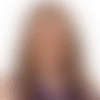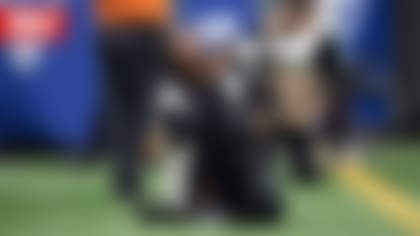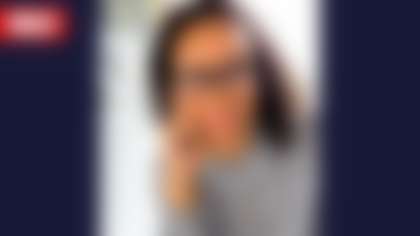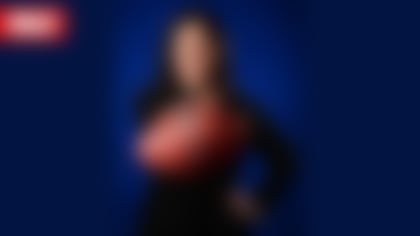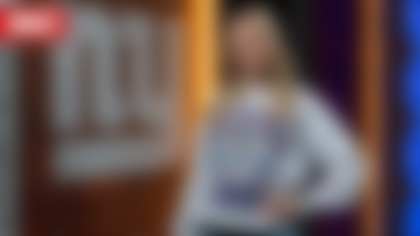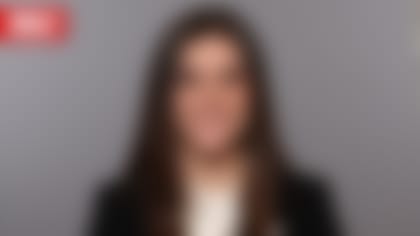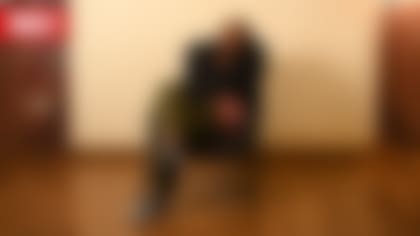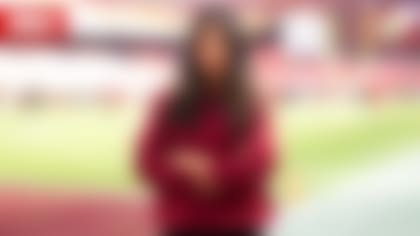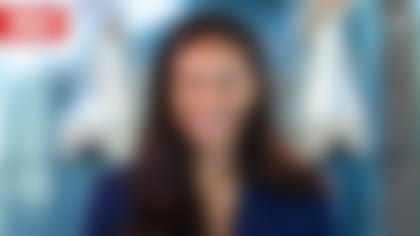Women are rising up the ranks throughout professional football, earning positions of power in a space that for too long was ruled almost exclusively by men. We're seeing more and more women breaking barriers in the sport, but what are the stories beyond the headlines? Who are the women shaping and influencing the NFL today? Answering those questions is the aim of the Next Woman Up series. While the conversational Q&As are edited and condensed for clarity, this is a forum for impactful women to share experiences in their own words. Without further ado, we introduce:
Chanelle Smith-Walker, Carolina Panthers
Position: Team Photographer
* * * * *
How did you get your start in a career in sports photography?
I'm actually a designer by trade. I got my degree in communications with a minor in visual arts from Elon University. I went to grad school at Southern Miss and was a grad assistant for their digital media department, so that's where I got my start in photography. I was hired full-time as their director of digital media after three months. I was doing graphic design, social media and photography, and I found that I really love taking photos. Then my career took off and Twitter became my best friend.
I got a direct message from the creative director at Baylor University and ended up joining them as the associate creative director for the football program, which is how I met coach Matt Rhule. Then I got another DM from the director of recruiting at the University of Tennessee, and I became the school's creative director. I was the first Black creative director in the SEC.
Now I'm here and it's my first time really focusing on just photography -- even though I've expanded it to more.
What does being a creative director entail?
Being a creative director, you are responsible for the look and feel of all of the content. That covers everything from graphics to video and photo content to social. All of those roles are slowly starting to separate but one person did all of it when I started.
When I was at Tennessee, I was chosen to be one of the designers for the 2021 College Football Playoff National Championship in Miami between Alabama and Ohio State. I was part of a lot of firsts. It was the first time they had a pair of female designers and a Black designer. It was fun to collaborate on the logo and content for the CFP platforms, designing for those two schools while also tapping into the Miami culture.
Now doing more photo-focused work with the Panthers, what have you learned about yourself?
First, I'll say that photography is so much harder than it looks. A lot of people think you can just point and shoot, but you have to know about lighting and what strobes and lenses to use depending on the event. I've learned so much about what camera bodies and lenses work better in certain situations. I'm the only photographer here for the Panthers, so not only am I shooting events or games but also archiving all of the photos so the entire organization has access to them.
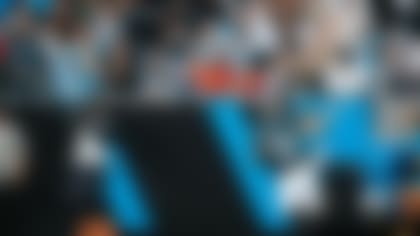
What are some of the more innovative things you've done during your time with the organization?
“My View” is a sponsored series that the Panthers have done during the season, and the biggest thing I've wanted to bring to it is a behind-the-scenes aspect. I like to talk about what goes into certain sets or how I was able to get a certain photo or why I chose a particular creative decision.
We just had the schedule release, which was huge for us. We did a 1990s theme and we really wanted to show our players' personalities because our fans aren't just fans because we win or lose; they love the players. I love being part of a creative team that does big projects like this and pushes the players to show their personalities outside of football.
What is the most challenging part of your job?
There are two things. The first is trying to balance all of the aspects of being a team photographer. Like I said, there is so much that goes into it, so much more than just taking photos. The second is people taking me seriously when I'm on the sidelines. I think there are less than 10 female photographers in the NFL and I only know of two who are Black -- Callena Williams from the Dallas Cowboys and me. Getting people to understand that we are in these roles because we know what we're doing is sometimes hard. People don't understand that.
There is a long way to go in terms of getting more women and women of color in these roles, but it's also about having people become more receptive to seeing someone like me on the sidelines. Getting people to respect me and not treat me like I'm incompetent because I'm a woman in this role is probably the biggest challenge. It's slowly but surely getting easier.
How does it make you feel knowing you're helping pave the way in this industry for women and women of color?
It's exciting but there is some underlying pressure that comes with it. It has opened up doors for people to connect with me. Many of them want to learn more about what I do or shadow me. It's allowed me to give opportunities to minorities who don't necessarily have access to shooting an NFL game or shadowing a photoshoot. We had four people shadow me for our TopCats production day earlier this year, and that was a great thing.
What kind of perspective do you bring to your position?
I'm not going to lie, I'm not a diehard football fan. But because I'm not attached to the game in that way, I feel like I'm really able to focus on our players' personalities and get a true shot that's different. There are always the photographers who will get the classic football photo of the player yelling in excitement but not everyone will get the guy behind him who is showing another emotion. I'm not just focused on the big thing. I'm trying to find the small moments, too, and I usually get those moments that everyone doesn't see. I do research before games by looking at players' social media accounts to see what's meaningful about this game or that game for them. If it's a special game because of breast cancer awareness month or an anniversary game of some kind, I'll know which players have a special connection to that particular game, so I can focus on them.
It's like the Keith Kirkwood photo I took in Week 7 last season. It was his first game back after being carted off the field during training camp and taken to the hospital by ambulance. The emotion in the photo says so much. It's definitely one of my favorite shots that I've taken.
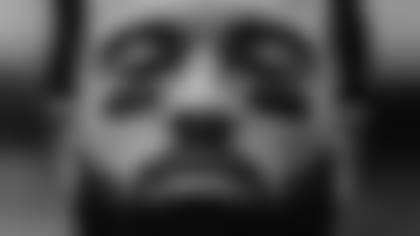
What advice do you have for women who want to get into a career in sports?
Don't be afraid to advocate for yourself. It's OK to fight for yourself and to be confident in your abilities. People might take advantage of people who aren't willing to stand up for themselves, so you have to be willing to do that.
That is great advice. What's next in terms of what you want to accomplish, whether in the short- or long-term?
The biggest thing I've always wanted to do is to give back and help minority creatives and people who just don't have opportunities. When you look at the creative industry as a whole, there's a big gap between people who have the privilege and access to big schools like Alabama and Texas -- schools with really big creative content programs -- and people who don't because they simply can't afford it. I wouldn't be doing what I do now if I hadn't gotten a volleyball scholarship to Elon University, so I want others to have the same opportunities regardless of where they come from or what situation they are in.
I'm in the first steps of starting a program with the Panthers. It's a job-shadowing externship, an eight-week program where young minorities can come in and shadow all parts of the department, and this will happen right after the season and through free agency. They won't be doing any work necessarily but they will be a fly on the wall to see what all goes into content creation so they can see if this is a career they really want to pursue.
The other thing I've been working on is a minority creatives workshop. We'll take 24 people who'll be broken up into four areas -- social, video, graphics and photo. We're supplying all of the equipment and gear for it. It's a one-day, eight-hour training session. For the first three hours, they will learn how to use the equipment and the second half is about mentorship and networking.
I've been blessed at the Panthers because they have been really supportive about these programs and helping them get off the ground. We have a very diverse creative team here and I think that shows in the work and projects we do.
I can't wait to hear how these programs turn out. Lastly, what are you most proud of?
(Tearing up with emotion) I wouldn't necessarily say anything that I've done, but representation is so important so I would say showing people that you can look like me and still be successful in this field. I'm sorry I'm so emotional. I want to inspire and I've received so many messages from people who say things like, "I lost hope then I saw your TikTok." I use TikTok to educate and guide people on where to look for jobs or how to do certain creative things.
I think my greatest accomplishment is inspiring people and showing them that they don't have to even like sports or go to big universities. They can do it. If you put your mind to it, you can figure out a way to get it done. I want to see more Black women doing this because there aren't many of us. I don't do this for awards. I do this because I love my craft and love being creative, and I just want to help people. I want to help get more women, especially minority women, in these roles.
